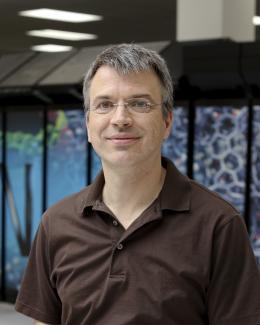Rare isotope oxygen-28 has been determined to be "barely unbound" by experiments led by researchers at the Tokyo Institute of Technology and by computer simulations conducted at ORNL. The findings from this first-ever observation of 28O answer a longstanding question in nuclear physics: can you get bound isotopes in a very neutron-rich region of the nuclear chart, where instability and radioactivity are the norm? Image credit: Andy Sproles/ORNL
Isotopes — atoms of a particular element that have different numbers of neutrons — can be used for a variety of tasks, from tracking climate change to conducting medical research.
Investigating rare isotopes, which have extreme neutron-to-proton imbalances and are often created in accelerator facilities, provides scientists with opportunities to test their theories of nuclear structure and to learn more about isotopes that have yet to be utilized in application.
One such rare isotope, oxygen-28, or 28O, has been the subject of a collaboration between researchers from 37 institutions and led by the Tokyo Institute of Technology. The number after the atom’s name refers to nucleons — the number of protons and neutrons that are bound together in the particle of the atomic nucleus. Notably, the oxygen that we breathe mainly consists of nuclei with only eight neutrons. The results from their first-ever investigation of 28O, recently published in Nature, answer a longstanding question in nuclear physics: Can you get bound isotopes in a very neutron-rich region of the nuclear chart, where instability and radioactivity are the norm?
In the atomic nucleus of 28O, 20 neutrons and eight protons interact via the strong nuclear force. Specific numbers of nucleons exhibit stronger binding energy than other configurations to form stable, non-radioactive isotopes. Hence, these numbers must be “magic,” a term coined by physicist Eugene Wigner in the late 1950s. Eight protons and 20 neutrons are both considered “magic,” thereby making 28O “doubly magic.” In fact, this special number of subatomic particles fills proton and neutron “shells” in the nucleus, resulting in stronger binding than neighboring isotopes on the nuclear chart. On the other hand, 28O is very neutron-rich, a condition that usually leads to instability from weaker binding.
“The question that we set out to answer is — if such configurations of nucleons are still magic as you go into this very neutron-rich, unbound region of the nuclear chart — could it be that such a nucleus would be particle bound?” said Gaute Hagen, a staff scientist at the Department of Energy’s Oak Ridge National Laboratory in the Theoretical and Computational Physics group of the Physics Division, who directed the project’s computer modeling effort.
Put simply, given its doubly magic numbers, could 28O be bound by the strong nuclear force? Or, because of its high neutron count, will it spontaneously emit neutrons and decay?
Using the Radioactive Isotope Beam Factory at the RIKEN Nishina Center for Accelerator-Based Science in Japan, the lead author Yosuke Kondo and his team conducted the first-ever experiments to observe the radioactive decay of 28O into 24O by measuring the direct emission of four unbound neutrons as 28O moved over the nuclear drip line — the point at which the nucleus became unbound and leaked or “dripped” the neutrons.
“The main conclusion from the experimental side is that they found this nucleus to be just barely unbound. So, it’s not particle bound. Beyond the neutron drip line, it cannot hold on to the neutrons long enough to form a stable configuration — but it’s just above what we call the ‘threshold’ for making a bound nucleus,” Hagen said.
Through advanced simulation studies on ORNL’s Summit supercomputer, Gaute Hagen, Thomas Papenbrock and Zhonghao Sun at ORNL; Andreas Ekström, Christian Forssén and Weiguang Jiang at Chalmers University of Technology; and Ian Vernon at Durham University confirmed with 98% probability that 28O is not a bound nucleus. But Hagen’s team also had bigger theoretical questions in mind, beyond determining if neutrons were unbound in 28O.
“From a theory point of view, it’s been interesting to address how this kind of exotic nucleus can be described from underlying microscopic forces between nucleons. What kinds of forces play significant roles in this very extreme region of the nuclear chart?” Hagen said. “Is it possible, with our current understanding of the strong nuclear force, to describe such a very exotic nucleus from what we call a first-principles approach? And if not, what could this experiment inform us about what might potentially be missing in the description of such exotic matter?”
The team could have simulated 28O and its direct decay of four neutrons by using computations that start from first principles — the physical laws that determine how matter and energy interact on a subatomic level — but that would have required lengthy computing time. To overcome that hurdle, Hagen used an emulator algorithm, which is a computational technique he developed with Ekström for a previous project. These algorithms are trained to address selected sets of parameters and emulate first-principles calculations to solve the problem at lower fidelity, which reduces computational cost. Then, using a statistical approach called “history matching,” the team crosschecked the models against other experiment data to iteratively produce an accurate model.
Without the emulators, one first-principles calculation would have taken a couple of hours on the 200-petaflop Summit, which is managed by the Oak Ridge Leadership Computing Facility, a DOE Office of Science user facility. For the 28O study, the ORNL team conducted 100 million evaluations over a few days.
“These emulators cost orders of magnitude less in computing resources, so we can perform 1 million emulations in a few minutes or up to an hour using just a laptop computer. If you were to do the same calculations from first principles, it would take more than a year on Summit,” Hagen said.
“We are learning how nuclei behave under extreme conditions and also how to describe them from first-principle approaches, which is now made possible by access to supercomputing. It’s opening a whole new avenue of possibilities in describing nuclei, making predictions and quantifying uncertainties.”
The project’s findings will contribute to exciting new research in nuclear physics that is examining the outer regions of the nuclear chart to learn more about rare isotopes and their properties. The DOE Office of Science has launched its newest user facility, the Facility for Rare Isotope Beams, at Michigan State University. It is dedicated to advancing such investigations, which may someday revise or amend current nuclear models.
“The traditional shell model approach to nuclei does not apply as you go toward the limits of the nuclear chart,” Hagen said. “You have this melting of traditional shells and other structure effects starting to play roles. This leads to a very different description than known from the standard textbooks. In that sense, new phenomena emerge, and small details of the strong nuclear force start to play a role in determining the limits of the nuclear chart.”
The work was conducted as part of Hagen’s ongoing project, Ab initio Nuclear Structure and Nuclear Reactions. Compute time for this project was awarded by the Innovative and Novel Computational Impact on Theory and Experiment program, which is jointly managed by the DOE’s Leadership Computing Facilities at Argonne National Laboratory and ORNL. DOE’s Office of Science supported the research.
UT-Battelle manages ORNL for DOE’s Office of Science, the single largest supporter of basic research in the physical sciences in the United States. DOE’s Office of Science is working to address some of the most pressing challenges of our time. For more information, visit https://energy.gov/science. —Coury Turczyn





